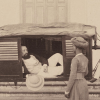[youtube id=”8QGMYmDLCrI” align=”center” mode=”normal” autoplay=”yes”]
A Socio-Cultural Awakening
What do India and Mexico have in common? On the surface, the similarities are not striking. However, digging deeper into the layers of history reveals a much broader insight into the legacies left behind on these two countries by the colonial-era empires of both Britain and Spain. History books and written primary sources layout a
19th Century photographs draw similarities among traditional dress and the portrayal of women across different cultures
Since the early 19th century, photography has been a crucial means of communication for citizens, governments, writers and artists. With the rise of photography during periods of colonial rule, however, came a new racial ideology (Ball-Phillips, Lecture). By examining photographs from similar periods in India and Mexico, cross-cultural connections about women, gender and historic dress
Views of an Empire
As I stood in the reading room of the DeGolyer library, I struggled to process the sheer amount of visual information being thrown at me. Before me stood three long tables which were scattered with various photographs, frail and aging, their warm, brown tints calling me closer. The DeGolyer library at Southern Methodist University
The Power of an Image
Amun Taharka KNW 2399 30 April, 2015 Visual Culture Analysis: The Contents of an Image What is contained in an image? The word image is defined as the physical representation of a person, place, or object according to dictionary.com.1 However, anyone who has seen any of Pablo Picasso’s famous paintings, or anyone who is
Rebellions, Revolutions, and Movements of Mexico and India
[iframe id=”https://www.youtube.com/embed/PzLxTYm8ts4″]
Railroads of Change
Caleb Tuke Edges of Empire 2399 Railroads of Change in Mexico and India Through the second half of the nineteenth century to the early twentieth century, railway construction in Mexico and India was pivotal in connecting different regions across the countries, and in the subsequent popular movements against the status quo in
Occupations in India and Mexico

The photograph titled, Ghatee Hamalls, or Bearers, was taken around the 1850s or 1860s by William Johnson, and displays six men outside a building. In the center of the photograph, there is a man who appears to be lounging in a raised-up compartment. The fact that he is being carried insinuates that he is too
Contribution of Railroads in Colonial India and Mexico
Introduction Throughout most of world history, railroad progress in developing nations was a precursor for mass industrialization, urbanization, and national progress. When the United States completed construction for the Transcontinental Railroad in 1869 it was able to transport goods and people faster and cheaper becoming the backbone to American economic growth. The cases were different
